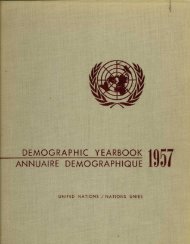Manual on Statistics of International Trade in Services
Manual on Statistics of International Trade in Services
Manual on Statistics of International Trade in Services
Create successful ePaper yourself
Turn your PDF publications into a flip-book with our unique Google optimized e-Paper software.
(a) c<strong>on</strong>sistency with <strong>in</strong>ternati<strong>on</strong>al standards related<br />
to trade <strong>in</strong> services, extend<strong>in</strong>g them where necessary and<br />
feasible;<br />
(b) phased implementati<strong>on</strong>.<br />
These pr<strong>in</strong>ciples facilitate the <strong>in</strong>troducti<strong>on</strong> and<br />
progressive implementati<strong>on</strong> <strong>of</strong> a set <strong>of</strong> dist<strong>in</strong>ct elements<br />
<strong>in</strong> a flexible way to meet each country’s priorities, at the<br />
same time progressively improv<strong>in</strong>g <strong>in</strong>ter-country<br />
comparability. Throughout its coverage <strong>of</strong> <strong>in</strong>ternati<strong>on</strong>al<br />
services transacti<strong>on</strong>s, l<strong>in</strong>ks are provided between the<br />
<str<strong>on</strong>g>Manual</str<strong>on</strong>g> and relevant <strong>in</strong>ternati<strong>on</strong>al standards.<br />
2.46. The <str<strong>on</strong>g>Manual</str<strong>on</strong>g>’s framework has two ma<strong>in</strong> build<strong>in</strong>g<br />
blocks for describ<strong>in</strong>g transacti<strong>on</strong>s <strong>in</strong> <strong>in</strong>ternati<strong>on</strong>al trade<br />
<strong>in</strong> services. These are transacti<strong>on</strong>s between residents and<br />
n<strong>on</strong>-residents (based <strong>on</strong> BPM5) and trade <strong>in</strong> services<br />
through the operati<strong>on</strong>s <strong>of</strong> foreign affiliates (the newly<br />
developed FATS statistical system). It is described here<br />
<strong>in</strong> four parts: BPM5 services and related transacti<strong>on</strong>s,<br />
BPM5 extensi<strong>on</strong>s, FATS statistics and a simplified<br />
statistical approach to the treatment <strong>of</strong> modes <strong>of</strong> supply.<br />
The four comp<strong>on</strong>ents are presented <strong>in</strong> paragraphs 2.51-<br />
2.101 below.<br />
2.47. The <str<strong>on</strong>g>Manual</str<strong>on</strong>g>’s statistical framework with<br />
regard to resident/n<strong>on</strong>-resident transacti<strong>on</strong>s is based<br />
<strong>on</strong> BPM5, which c<strong>on</strong>ta<strong>in</strong>s, am<strong>on</strong>g other th<strong>in</strong>gs,<br />
recommendati<strong>on</strong>s for the def<strong>in</strong>iti<strong>on</strong>, valuati<strong>on</strong>,<br />
classificati<strong>on</strong> and record<strong>in</strong>g <strong>of</strong> resident/n<strong>on</strong>-resident<br />
trade <strong>in</strong> services. BPM5 is a primary source <strong>of</strong><br />
statistical guidance <strong>on</strong> <strong>in</strong>ternati<strong>on</strong>al trade <strong>in</strong> services,<br />
<strong>in</strong>ternati<strong>on</strong>al <strong>in</strong>vestment transacti<strong>on</strong>s and ec<strong>on</strong>omic<br />
flows associated with the movement <strong>of</strong> workers.<br />
Extensi<strong>on</strong>s to BPM5 are developed <strong>in</strong> the <str<strong>on</strong>g>Manual</str<strong>on</strong>g> to<br />
provide for a more detailed treatment <strong>of</strong> service<br />
transacti<strong>on</strong>s between residents and n<strong>on</strong>-residents by<br />
product category and by partner countries. The<br />
<str<strong>on</strong>g>Manual</str<strong>on</strong>g> does not set out to change the BPM5 broad<br />
service comp<strong>on</strong>ents but it does call for more detail so<br />
as to identify services that feature significantly <strong>in</strong><br />
<strong>in</strong>ternati<strong>on</strong>al trade <strong>in</strong> their own right. Examples <strong>of</strong><br />
this more detailed treatment are <strong>in</strong> the areas <strong>of</strong><br />
transport, communicati<strong>on</strong>s, computer and <strong>in</strong>formati<strong>on</strong><br />
services, bus<strong>in</strong>ess and pr<strong>of</strong>essi<strong>on</strong>al services, and<br />
pers<strong>on</strong>al services.<br />
2.48. In additi<strong>on</strong> to trade <strong>in</strong> services between<br />
residents and n<strong>on</strong>-residents, services may be supplied<br />
through foreign affiliates <strong>in</strong> host countries. The FATS<br />
statistical system, which draws to a great extent <strong>on</strong> the<br />
c<strong>on</strong>cepts and def<strong>in</strong>iti<strong>on</strong>s c<strong>on</strong>ta<strong>in</strong>ed <strong>in</strong> the 1993 SNA,<br />
has been designed to provide <strong>in</strong>formati<strong>on</strong> <strong>on</strong> the<br />
activity <strong>of</strong> foreign affiliates that is out <strong>of</strong> the scope <strong>of</strong><br />
16<br />
BPM5. The <str<strong>on</strong>g>Manual</str<strong>on</strong>g>’s framework is based <strong>on</strong> FATS<br />
statistics as a complement to, and <strong>in</strong> parallel with,<br />
BPM5.<br />
2.49. The <str<strong>on</strong>g>Manual</str<strong>on</strong>g> proposes a simplified statistical<br />
approach that may be used as a start<strong>in</strong>g po<strong>in</strong>t <strong>in</strong><br />
allocat<strong>in</strong>g BPM5 and FATS service transacti<strong>on</strong>s to the<br />
GATS modes <strong>of</strong> supply. This approach draws <strong>on</strong> the<br />
corresp<strong>on</strong>dence between commercial presence and<br />
FATS, as well as between the other modes <strong>of</strong> supply and<br />
transacti<strong>on</strong>s between residents and n<strong>on</strong>-residents, as<br />
captured <strong>in</strong> BPM5. It also <strong>in</strong>cludes systematic criteria for<br />
the allocati<strong>on</strong> <strong>of</strong> modes <strong>of</strong> supply and simplify<strong>in</strong>g<br />
methods and guidel<strong>in</strong>es for the treatment <strong>of</strong> complex<br />
transacti<strong>on</strong>s. Because delivery <strong>of</strong> services through mode<br />
4 can be measured <strong>on</strong>ly <strong>in</strong> part through the BPM5 and<br />
FATS systems, the <str<strong>on</strong>g>Manual</str<strong>on</strong>g> also outl<strong>in</strong>es the issues<br />
aris<strong>in</strong>g <strong>in</strong> a more comprehensive measurement <strong>of</strong><br />
services provided through mode 4.<br />
2.50. The descripti<strong>on</strong>s <strong>of</strong> BPM5, its extensi<strong>on</strong>s, FATS<br />
statistics and issues surround<strong>in</strong>g mode 4 statistics are<br />
discussed <strong>on</strong>ly briefly <strong>in</strong> the present chapter because<br />
fuller descripti<strong>on</strong>s are provided <strong>in</strong> chapters III and IV<br />
below and annex I.<br />
1. <strong>Statistics</strong> <strong>on</strong> trade <strong>in</strong> services, labour and<br />
<strong>in</strong>vestment from BPM5<br />
2.51. Balance <strong>of</strong> payments statements summarize the<br />
ec<strong>on</strong>omic transacti<strong>on</strong>s <strong>of</strong> an ec<strong>on</strong>omy with the rest <strong>of</strong><br />
the world for a specific period. Two key c<strong>on</strong>cepts are<br />
<strong>in</strong>volved: transacti<strong>on</strong> and residence. A transacti<strong>on</strong> is<br />
an ec<strong>on</strong>omic flow that reflects the creati<strong>on</strong>,<br />
transformati<strong>on</strong>, exchange, transfer or ext<strong>in</strong>cti<strong>on</strong> <strong>of</strong><br />
ec<strong>on</strong>omic value, and <strong>in</strong>volves change <strong>of</strong> ownership <strong>of</strong><br />
goods and/or f<strong>in</strong>ancial assets, the provisi<strong>on</strong> <strong>of</strong><br />
services, or the provisi<strong>on</strong> <strong>of</strong> labour or capital.<br />
Residence is central because the identificati<strong>on</strong> <strong>of</strong><br />
transacti<strong>on</strong>s between residents and n<strong>on</strong>-residents<br />
underp<strong>in</strong>s the BPM5 system. The def<strong>in</strong>iti<strong>on</strong> <strong>of</strong><br />
residence that is used <strong>in</strong> BPM5 is identical to that <strong>in</strong><br />
the 1993 SNA, and is based <strong>on</strong> a transactor’s centre <strong>of</strong><br />
ec<strong>on</strong>omic <strong>in</strong>terest. S<strong>in</strong>ce political boundaries may not<br />
always co<strong>in</strong>cide with those appropriate for ec<strong>on</strong>omic<br />
purposes, the ec<strong>on</strong>omic territory 33 <strong>of</strong> a country is used<br />
as the relevant geographical area for the characteristic<br />
<strong>of</strong> residence. An <strong>in</strong>stituti<strong>on</strong>al unit is a resident unit<br />
when it has a centre <strong>of</strong> ec<strong>on</strong>omic <strong>in</strong>terest <strong>in</strong> the<br />
ec<strong>on</strong>omic territory <strong>of</strong> a country.<br />
33 For a def<strong>in</strong>iti<strong>on</strong> <strong>of</strong> ec<strong>on</strong>omic territory, see para. 3.4 below.

















